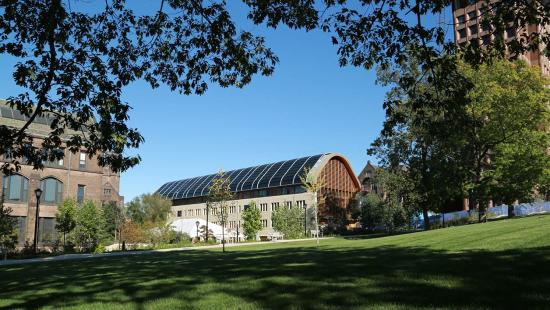
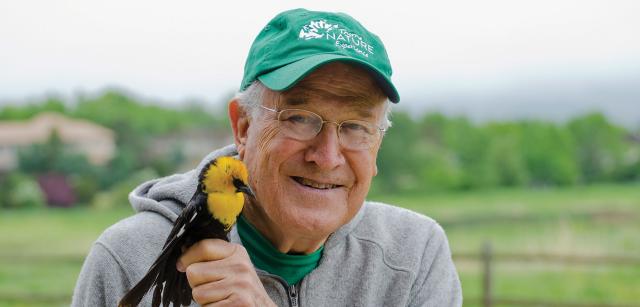
Bird-bander Oak Thorne '53 handles a yellow-headed blackbird.
Personal and professional news and updates from YSE's more than 5,500 alumni around the world.
Classes of 1953-1983 | Classes of 1984-2003 | Classes of 2004-2022
-
Class of ’53
Class VolunteersStanley L. Goodrich, Earl W. Raymond
Dr. Oakleigh Thorne II writes: “At 93, I still go to work each day at Thorne Nature Experience (Thorne Ecological Institute), a nonprofit that I founded in 1954. We connect kids and youth to nature through classes and field trips. As a master bird bander, I teach a bird-banding class in the month of June each year to 12–15-year-olds. We band lots of red-winged blackbirds and hundreds of cliff swallows. Two of my former students are now in grad school at Yale, one in ornithology and one in environmental engineering!”
-
Class of ’54
Class VolunteersRichard A. Chase, Gordon Hall
Richard Chase writes: “I’m still enjoying retirement in the North Carolina Piedmont after a challenging 40-year career with the U.S. Forest Service followed by 10 years in private consulting. Time with the USFS was equally divided among varied assignments on three national forests, the National Office Fire & Aviation staff, and in fire research developing methodology to incorporate benefit/cost considerations into fire protection program planning and budgeting locally and nationally. An early surprise in my career came in my second year, when I was asked if I might know how to carry out a timber reinventory and recalculate the annual allowable cut for the ranger district (a major fire four years earlier making a reduction from the current cut necessary). The expertise on how to go about doing that apparently not being available among more experienced foresters, the forest supervisor wondered if my master’s degree from Yale might have included that very technical subject, which, of course, it did in Professor Meyer’s ‘Forest Management’ class. The somewhat humorous side of this is that as we spent time in class wading through the detailed technical steps involved, the question of why — when the probability that any of us would ever get to actually do it was about zero — was broached more than once! My response to the forest supervisor was a quick, confident ‘sure,’ and I got to spend the next several months getting to know the whole ranger district intimately on foot as I took many dozens of sample plots for the calculations involved in the sustained-yield formula.”
-
Class of ’55
Class VolunteersLawrence B. Sunderland
Richard Bury writes: “Never thought I’d last this long! Still in good health, living in the beautiful southern Appalachians in Asheville, North Carolina. Active in environmental management of our retirement community of 700 persons within a forested hilly property of 50 acres. Rereading (for the third time) the five-volume series, ‘Early Days in the Forest Service,’ published by the Northern Region, USFS, Missoula, Montana, and Northern Rocky Mountains Retiree Association, Missoula. Absolutely wonderful stories written by the guys working 1900–1950. Living conditions, life of their wives, boundary establishment, inventory, firefighting, horse- and mule-packing, rafting through wild waters, fire lookouts, grazing administration, etc. They were a truly tough bunch!”
Larry Sunderland writes: “For the past two years my wife and I have been living in someone’s idea of an arboretum, now a retirement community. Our cottage is feet away from a steep strip of Douglas fir forest separating us from the Willamette River flood plain. It was assumed I could name and label 30+ tree species. I knew three, the rest unfamiliar mostly from Asia, Europe, and Australia. My career: five years in Northern California (redwood lumber, cruising); 25 years in Washington, D.C., and Geneva, Switzerland (foreign trade tariffs, policy and disputes, a good part about forest products); the rest in New Hampshire managing my own forestland, teaching foreign marketing at Keene State, and volunteering with environmental organizations (forests, birds, lakes).”

-
Class of ’56
Class VolunteersPatrick J. Duffy
Patrick Duffy writes: “Chaired the Canadian Task Force to write the National Environmental Impact Assessment Policy and Procedure (1972) and co-authored the FAO EIA Guidelines for the Field Projects (2012), thus received the 2013 Outstanding Service Award from the International Association for Impact Assessment. I have also enjoyed mentoring forestry students at the University of British Columbia and IAIA entry workers for 20 years. Half of the 1,000 UBC students are women! Over my career I was fortunate to work in over 40 countries, half with U.N. agencies. Recently I made a five-year grant to UBC to aid co-op students with travel and per diem costs to remove a barrier to international travel. And I give to The Forest School, with happy memories being on the executive board of the student body in the mid-1950s.”
-
Class of ’61
Class VolunteersKarl Spalt, R. Scott Wallinger
Scott Wallinger writes: “I just finished, with Jamie Lewis of the Forest History Society, a presentation on the history of the Appalachian Society of American Foresters for its centennial meeting; for me, a look back after 65 years as an SAF member. This year I’m past chair of the Lowcountry Land Trust, winding up seven years on its board. We’re celebrating 35 years of work with 150,000 acres protected in the South Carolina Lowcountry. At the Bishop Garden retirement community where I live, I chair its arboretum group. Our arboretum was just recertified by ArbNet, an international body based at the Morton Arboretum in Illinois.”
ALUMNIFIRE
Connect with more than 1,200 YSE alumni and students around the globe and across the decades jobs , events and mentoring - all on one site!
Click here for more information or visit yse.alumnifire.com
Let us know how you are doing
Email us at alumni.yse@yale.edu
-
Class of ’61
Class VolunteersKarl Spalt, R. Scott Wallinger
Scott Wallinger writes: “I just finished, with Jamie Lewis of the Forest History Society, a presentation on the history of the Appalachian Society of American Foresters for its centennial meeting; for me, a look back after 65 years as an SAF member. This year I’m past chair of the Lowcountry Land Trust, winding up seven years on its board. We’re celebrating 35 years of work with 150,000 acres protected in the South Carolina Lowcountry. At the Bishop Garden retirement community where I live, I chair its arboretum group. Our arboretum was just recertified by ArbNet, an international body based at the Morton Arboretum in Illinois.”
-
Class of ’63
Class VolunteersJames Boyle
Bob Latham writes: “Still vertical but too tottering to do useful work. My wife and I have sold our ranch/tree farm in eastern Oregon and moved back to Corvallis. The CRC Press published my book, ‘Forensic Forestry,’ a few months ago. I’m not planning on royalties to sustain retirement, but it seemed like a useful endeavor. TGIF.”
Albert Stoll writes: “Thank you, Yale School of Forestry (1963 name!), for giving me 59 years of memories, huge environmental knowledge, and the social desire — the guts — to speak out on behalf of the earth’s precious environment. My memories arose out of Dr. Albert C. Worrell advocating for my desire to study the social impact humans have on the environment. Dr. Worrell, an open-minded forest policy and economics professor at the time, arranged for me to take classes from Yale’s Industrial Psychology Department — outside the regular curriculum — from a professor named Chris Argyris. This changed my life! I learned simple things like ego, social structures, culture, self-esteem at the naïve age of 23. Since then, I’ve done social research on human-caused forest fires for the PSW Forest and Range Experiment Station, taught forestry at a small California junior college, and, recently, successfully advocated to protect an abandoned golf course from losing its open-space value! I lost my own home October 9, 2017, to the same wildfire the golf course’s fire break diverted from thousands of other adjacent homes (not exaggerating) in the Wikiup-Larkfield, California, area. Dr. Argyris was absolutely the inspiration of my life, thanks to Dr. Worrell and the Yale School of the Environment’s open-minded, flexible student attitude. Sadly, my father passed when I was attending Yale; otherwise I would have never left the exciting Yale experience.”
-
Class of ’64
Class VolunteersStewarded by the office of development and alumni services
Adolfo (Jun) Valenzuela Revilla Jr. writes: “I will be 83 in a few months, but my problem for six years now has been my weak heart due to ‘heart failure condition with only 21% ejection fraction.’ My only remaining asset is my natural still-undyed hair. Anyway, I have put the solution to widespread poverty, the sustainable development system with the three integral components, in adequate detail so that our younger, healthier colleagues in all fields and disciplines can master the theory, concepts, and processes involved for its successful implementation. I am hoping that we can get the next president to implement the SD system. If so, I hope to witness the initial processes including the pilot projects — I believe that once the SD system implementation reaches its third or fourth year, then we will be on our way to success!? And my dream, since 1987, of liberating our poor families from the shackles of widespread poverty will start to become a reality!? Anyway, regardless of what happens, this will be my legacy to the Filipino people and humankind!”
-
Class of ’65
Class VolunteersGuy L. Steucek
John Blouch writes: “Reconnected with Jun Revilla ’64, ’78 PhD, cabin mate at Crossett in spring of ’64. COVID-related wood pricing brought a 50% increase on offer for timber on the wood lot, but shifting management focus toward aesthetic value for development as houses appear on adjacent plots. No COVID or even common cold as a result of social distancing, masks, inoculation, and handwashing. Understand why the elderly, seen in ports of Southeast Asia during Vietnam, wore masks. As previously, mill closed just as pandemic hit. If it had to be, timing was fortunate. Heavy air schedule would have become a nightmare of delays and cancelations. Health great but 30-pound bag of bird seed more of a challenge than 100-pound bag of portland cement in Yale days’ summer job. ‘Sic transit gloria mundi.’”
-
Class of ’71
Class VolunteersJoseph L. Deschenes, Harold T. Nygren
Ron Wilson writes: “I am enjoying life as a semiretired forester working part time for a medium-sized plantation company with head office only one suburb away from where I live in Sydney. I ride an e-bike to work. The major fires of 2019–2020 had major impact on our company as around 30% of our softwood plantations were burnt. Fortunately, most were insured but a lot of extra work in sorting out replanting/rehabilitation of the burnt areas and investors. COVID has been a real challenge here. I am currently involved in policy with colleagues to attempt to get more plantations established in Australia, for many good reasons. Other than work, I am busy with family (five grandchildren), cycling, swimming, golf, and playing the sax in a jazz band.”
-
Class of ’72
Class VolunteersMatthew Rosen, Stephen R. Wells
Phil Nemar writes: “We survived a second straight dry, smoky summer in a row without our place burning up. The 2020 Sheep Fire burned to within 0.6 mile of our house and the 2021 Dixie Fire was within seven miles. Evacuated both times. The two fires burned over 2,000 acres of client forests with light- to severe-intensity burns. With extreme fire behavior, it is impacting our thinking about how to grow Sierra Nevada forests sustainably in a world of climate change. It is a major new silvicultural challenge. Meanwhile, we’ve been to Carmel, Glacier National Park, the Oregon coast, Lassen Volcanic National Park, Pinecrest Lair of the Bear, and the Bay Area. Hoping for international travel this year.”
-
Class of ’73
Class VolunteersClyde H. Cremer, Thomas J. Dunn
Roy Deitchman writes: “I ‘retired’ as class secretary after about 40 years. However, I discovered my retirement hobby is working. I work full time at the National Institutes of Health doing environmental health and industrial hygiene work. Also, I serve on the Montgomery County (Maryland) Air Quality and Climate Change Committee trying to significantly reduce GHGs in the next 15 years.”
-
Class of ’74
Class VolunteersR. Lautenschlager, Norman A. Noyes
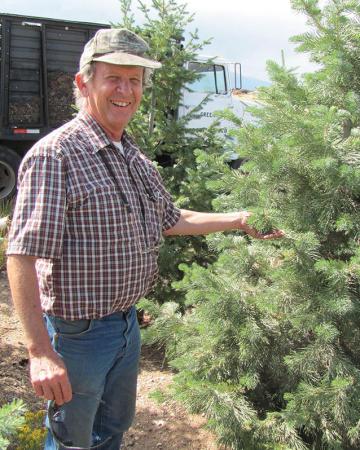
Len Lankford ’74 MF checks on the trees at one of the Greenleaf tree farms. Len Lankford writes: “Still here (since 1975) in the spectacular Sangre de Cristo mountains of southern Colorado! A far cry from New Haven. Practicing private forestry, which evolved by necessity into a full circle integration of forestry, nursery, and sawmill. Check out greenleafforestry.com. I am looking for motivated successors (forestry, operations, business management, marketing, wood products, etc.) to run and enjoy this business, so contact me soon: len.at.greenleaf@gmail.com. Our Lankford family has three amazing kids doing unusual things — daughter Claire Harper in Denver (USFS Forest Legacy Program); daughter Angela running treks and a lodge at 12,500 feet in Tibet (definitelynomadic.com) with her nomadic yak herder husband, Djarga; and son Tim in Westcliffe as my business advisor and doing technical real estate sales data analysis. Come visit us at Westcliffe, Colorado, to enjoy a small rural town and what our community-based forestry business is doing.”
Liz Mikols writes: “Warm wishes from an unseasonably cold Silver City, New Mexico. I spent New Year’s in Yellowstone. The driving skills I honed in New England and upstate New York came in handy as I drove through true winter weather between southern New Mexico and Bozeman, Montana. Wonderful views of bison, elk, and trumpeter swans, to name a few. Geysers, fumaroles, and mud pots look fabulous in winter. Talked a bit of forest ecology with the guides, so my Yale degree is apparently still valid. Also discovered the wonders of Yaktrax. My total knee replacement surgery last August went well, so I’m back to teaching aerobics, tai chi, and zumba. Anyone is welcome to visit me to see Aldo Leopold’s old stomping grounds (a 30-minute drive away).”
-
Class of ’75
Class VolunteersJennifer S. Belovsky, Hallie Metzger
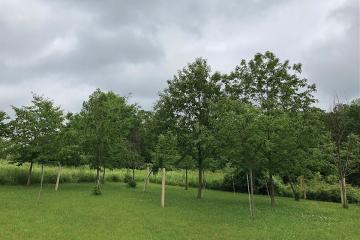
A test plot of hybrid American chestnuts on the property of Hallie Metzger ’75 Terry Chester writes: “It is a cold winter here in Sun Valley, Idaho. Had some nice FaceTime with some YSE classmates recently. Businesswise, I am happy to announce we’ve launched a new Adbiz website, adbiz.com! Thank you to everyone who made these past 25 years so rewarding! The ‘Mad Scientist of Marketing’ is alive and well!”
Hallie Metzger writes: “The pandemic continues to keep me mostly homebound as snow falls and wind howls off Lake Michigan. That gives me more time and incentive for YSE matters, such as our not-too-distant Class of ’75 50th reunion. And I am so privileged to serve on the Alumni Association Board. We are tackling serious issues such as DEI and environmental justice. I’m hoping to visit New Haven and my family forest property this summer, especially the test plot of hybrid American chestnuts. I haven’t been out since last June!”
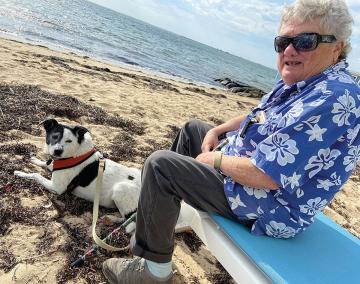
Helen Waldorf ’75 and her dog, Julie, enjoy some beach time.. Doug Ryan writes: “My wife, Lillian, and I are retired and staying healthy and at home in Olympia, Washington. We consider ourselves lucky because we continue to get together regularly with both of our children and their families, including our three grandchildren, thanks to vaccinations and careful planning. During my stay-at-home time I have completed a long-running volunteer project editing a book drawing together research on biological responses to stream nutrients from 17 experimental forests. The book was published in 2021 by the U.S. Forest Service, and, if the topic interests you, you can download it free of charge. Look us up if you are in the Pacific Northwest!”
Helen Waldorf writes: “My spouse, dog, and I are living by the beach in Massachusetts. I have been doing a lot of volunteer work with American Society for Testing and Materials International. Committee E50 on Environmental Assessment, Management, and Corrective Action has formed a new subcommittee, E50.07 on Climate and Community. We would love some help on water; power; mapping; environmental, social, and governance standards to respond to underserved communities.
-
Class of ’76
Class VolunteersThomas Barounis, Thomas Marino, Alan Poole
Tom Barounis writes: “After a very full career in environmental protection (13 years with the state of Illinois in air pollution control and 31 years with the U.S. EPA in hazardous waste cleanup), I have finally retired. I have always felt, and said, that my years at YSE were personally transformative; all reflection confirms that sentiment now that I’ve hung up my Pulaski (figuratively speaking). I met my wife, Diane Barounis ’75, in Helen Hadley Hall the third day I showed up in New Haven back in September 1974. We have been blessed with two great kids; four wonderful grandchildren; and a retreat in Door County, Wisconsin, to which we get away often. Experiencing the four seasons in the Midwest is a rich experience, much as it is in New England. It has been heartening to see how the School has grown and evolved over the years. My best wishes to all of the students. They have chosen work of which they can be proud. And to the staff and professors who motivate and help guide them.”
Sally Hasted writes: “Alas! In June 2020, the hospital where I taught emotionally fragile teens about dinosaurs, minerals, literature, art, and every nature topic they adored decided it was time for me to retire. I’d taken time off to keep my husband (seven years older) safe from COVID; without warning, the program moved on without me. I’m now relishing ‘homesteading’ in Connecticut, refurbishing an ancestral house near my beloved Massachusetts wetlands and shoreline, and caring for Jack. It’s all good but not very contributive to environmental restoration. Still, in Wilton, our home is stuffed with nature specimens; books on every subject; all our writings; and a lifetime of shells, emotionalia, and travel clutter, which Jack calls ‘the collection.’ Someone wrote, ‘A celebrated collection is the legacy of one curious person.’ Well, that’s us! Hopefully I’ll get back into working for the environment but not quite yet. Jack’s having some mobility trouble, possibly from COVID, so we must bide our time and get him healthy first. Then give me a paper map, stubby pencil, notepad, and compass, and I’ll be off mapping and discovering wonderful things about woods, fields, and wetlands! But no digital paraphernalia; I’m strictly hands-on and immersion. Meanwhile I’ve written some fun stuff that I’d love to get published.”
Alan Poole writes: “Checking in from the highlands of Costa Rica, where I now spend January to March. Based at the OTS Las Cruces biostation here, focused on writing about birds. My latest project: resplendent quetzals, flagship species for cloud forest preservation and major tourist draw. Cornell will publish; book out in six months. Classmates and other YSE folks encouraged to visit; the station provides excellent accommodations. Beats winter at home in Massachusetts!”
Bob Seymour writes: “I retired in 2017 after 39 years at the University of Maine, the last 30 of which were spent teaching silviculture and other advanced courses and doing all kinds of silviculture research. Along with my wife, Jessica Leahy, who also serves on the UMaine faculty, I spend much of my time working our own woodlands (nearly 500 acres in east-central Maine); woodworking, smallmouth bass fishing, gardening, and grandparenting are also pleasures. I write a monthly column on silviculture for the Maine Woodlands newsletter, and one of our tree farms, Wicopy Woods, was Maine’s outstanding tree farm in 2020. I was named a fellow of the Society of American Foresters in 2008 and won SAF’s Carl Schenck Award for national excellence in college forestry teaching in 2014 — two honors of which I am very proud. I also started a YouTube channel, mostly to capture numerous silviculture how-to videos I began recording a few years ago, that is surprisingly popular for a forestry site.”
ALUMNIFIRE
Connect with more than 2,000 YSE alumni and students around the globe and across the decades jobs , events and mentoring - all on one site!
Let us know how you are doing.
Email us at alumni.yse@yale.edu
-
Class of ’77
Class VolunteersTracy Kay
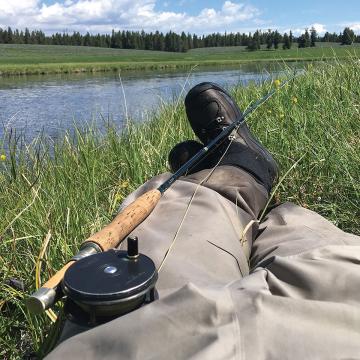
Dave Hall ’77 relaxes on the bank of Idaho’s Henrys Fork of the Snake River. Dave Hall writes: “I miss the many wonderful friends I made in New Haven — two memorable years. Becky and I now split the year between Salt Lake City and the banks of the Henrys Fork of the Snake in Last Chance, Idaho, where I fish parts of most days. I continue to paint half the year, providing oil landscapes to galleries in the northern Rockies. I am very proud of the fact that my art donations over the years have raised more than $100K for conservation nonprofits in the greater Yellowstone ecosystem. If you’re interested: DaveHallFineArt.com.”
Andrew Melnykovych writes: “Still in Louisville. Will mark two years of retirement in April by marrying off our daughter. Continue to do consulting (paid and unpaid) for utility regulators in emerging economies. Managed to cram some travel into the Delta-Omicron gap and look forward to getting out more in 2022. Keeping busy with birding — teaching introductory classes through the local public library and the park system founded by Dan Jones ’06.”
-
Class of ’78
Class VolunteersSusan Curnan, William C. Davis, Regina Rochefort
Susan P. Curnan writes: “After nearly 40 years on the faculty and as many years working in the field, I am very happy to announce the launch of a new MPP/MBA concentration in environmental justice at the Heller School for Social Policy and Management at Brandeis University. I am honored to be the inaugural chair of the program and teach the flagship course ‘Climate Change and Inequalities.’ My time at the Yale School of the Environment was critical in shaping my worldview and career trajectory as a nature lover, professor of the practice, and avid environmental steward. I look forward to hearing from and reaching out to Yale colleagues, alumni, and students as we grapple with the challenges and crises ahead. My current favorite bumper sticker: ‘There is no Planet B.’ Cheers from the North Shore of Massachusetts.”
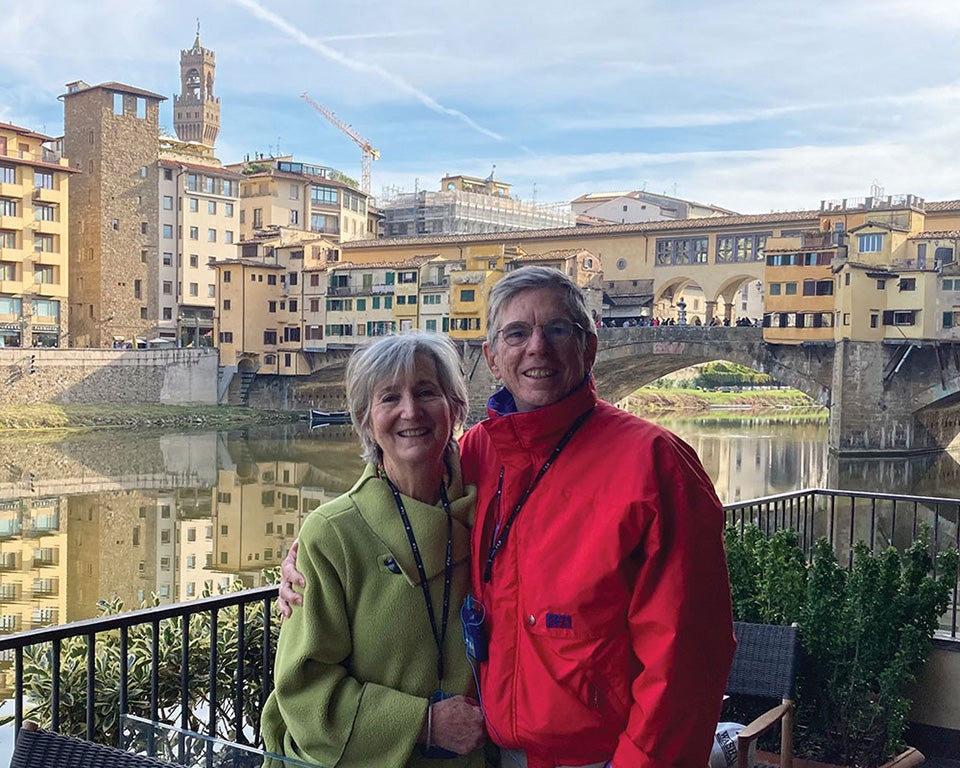
David Wentworth ’78 and his wife, Betsy, seeing the sights in Florence, Italy. David Wentworth writes: “After more than five decades, perhaps it’s time I submit my first class note. I’ve ended up a long way from the environmental training I got at Yale. I changed careers in my early 30s and have spent almost 40 years as a tax policy expert, the last 10 years giving tax policy advice to developing countries (mostly through the IMF). Living in metro Washington, happily married (for 37 years), two wonderful adult daughters (but no grandchildren yet), and trying to figure out what the last chapter of my life looks like. Balancing part-time work with part-time play is proving a challenge. We travel a lot but have never been to Alaska, so a cruise out of Juneau is now scheduled for August. And we’ll both celebrate our birthdays there!”
-
Class of ’79
Class VolunteersJohn Carey, Pat Leavenworth
Richard Guldin writes: “Actively engaged in consulting work related to forest inventories and reforestation/afforestation policies at global, national, and subnational scales. Published an article last summer in Frontiers in Forests and Global Change on the state of the science outside the U.S. in small domain estimation research and applications in forestry. I’m also participating in the Forest Climate Working Group, especially interested in the forest science-forest policy interface. For fun, I’m building mission-style rocking chairs out of quarter-sawn white oak (four so far; willing to share my plans) and assorted other pieces from jewelry boxes to nightstands and chests of drawers.”
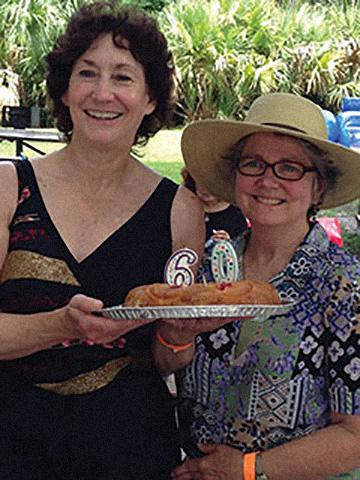
Ellie Lathrop-Deischel ’80 and Dorie Karl ’79 celebrated their 60th birthdays, June 11, 2021. Dorie Karl writes: “I’m single, retired from my second career (volunteer management), and chasing two long-neglected passions. ‘Franklin’s Feathers’ is a narrative nonfiction picture book I’m writing about a peacock that strayed onto my 10 forested acres in Florida and led a zany, feral life with me and my 10 grandkids for almost 20 years. I plan to publish in 2022. I also delight in painting wildflowers and landscapes in watercolor. Several exotic plants on my property torment me, which Ellie Lathrop ’80 can attest to after a day of eradication on one of her visits. Y’all are welcome to visit. My cabin’s in Hawthorne, 25 miles from the University of Florida in Gainesville, and has plenty of room for friends of yore.”
Bob Perschel writes: “I’m still the executive director for the New England Forestry Foundation, where we are fully focused on mitigating climate change through our region’s forests. Our analysis indicates that New England’s forests can offset 30% of New England emissions over the next 30 years by establishing reserves, changing forestry practices to Exemplary Forestry standards, and building tall buildings with wood instead of concrete and steel. Professor Brad Gentry’s students at the School helped us pull a policy initiative together. We look forward to two upcoming reports from Highstead Foundation and the University of Maine to support our conclusions, and then we’ll attempt to direct climate funding toward financial incentives for landowners and builders to make the change.”
-
Class of ’80
Class VolunteersStarling W. Childs, Robert D. Comer, Sara Schreiner Kendall
Natasha Atkins writes: “Since I graduated a semester late, I’ve been identifying with the Class of 1980. Although I continue to do freelance scientific editorial work, most of my energy is as a volunteer on the editorial board of the Journal of Caribbean Ornithology, a trilingual publication of the NGO BirdsCaribbean. We work to engage Caribbean ornithologists, many of whom are students or professionals in local conservation organizations and agencies. And at home, near Amazon’s new HQ2 site, I’m working to push for greater commitments to sustainability, tree canopy, bird-friendly architecture, and native landscaping in all the new development sites. Come visit! There’s always a bed for my fellow Stumpies.”
Bob Currie writes: “My wife, Polly (45 years), began portrait painting just as COVID began in March 2020. I’ve included her latest: Felicity, one of our 11 grandchildren. We headed to Florence on February 9 so Polly can take an intense, four-week course.”
Ken Olson writes: “Retired president and CEO of Friends of Acadia; observe politics, the natural scene, and other subjects from my new home in Jackson, New Hampshire. I’ve been writing across genres. For the book ‘Acadia National Park: A Centennial Celebration,’ Maine Writers and Publishers Alliance, the co-authors and I were finalists for the 2017 John N. Cole Award for Maine-themed nonfiction. In 2021, I was named a Maine Literary Awards finalist for the short collection ‘Common Cause and Other Poems.’ Overstory, a Yale Forest Forum publication, recently ran my poem ‘Hydro Logic: Why Slow Rivers Have S-Curves,’ dedicated to the memory of Brian J. Skinner, Yale professor of geology.”
Jane Sokolow writes: “Early 2022 finds me in not very different circumstances from early 2021. We are pretty much hunkered down primarily in Riverdale but managing to get up to our old farm in the Catskills on weekends. Both Ned and I are active on several boards — me on the Bronx Council for Environmental Quality and The Natural Areas Conservancy of NYC and Ned on The Cary Institute and a family trust. I am supposed to be on the planning committee for my 50th reunion from college, but it remains unclear if the event will happen in person. We managed a trip to Pennsylvania in May, where the family gathered to dedicate a bench and native plantings to my late brother, Martin H. (‘Mike’) Sokolow Jr. ’72 (1948–2020), on the headwaters of the LeTort Springs Run, a piece of property he helped preserve for the Central Pennsylvania Conservancy. In July we got out to the family ranch in New Mexico before the Delta variant hit. Staying in touch takes on a whole new meaning in these times of limited meetups. I am grateful that the Class of 1980 nation remains close and in communication. I cherish these friendships.”
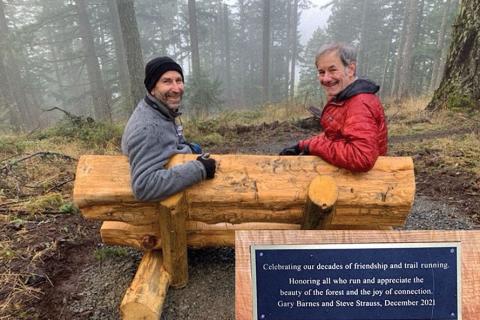
Steve Strauss ’80 (left) and friend Gary Barnes (right) share a laugh at the dedication of their new bench on a favorite trail in the Oregon State University Research Forest. Steve Strauss writes: “I celebrated 50 years of running this year by donating a bench to the College Forest at Oregon State, with a focus on trail running with my longtime running buddy. Of course, it’s on the Beautiful Trail there. Yes, am still trail running at 66 and hope to make it a few years longer. Hope you are all well.”
-
Class of ’81
Class VolunteersFred Hadley, Gail Reynolds, James R. Runyan
Martha Davis writes: “Who knew retirement could be so busy! I am working on a combination of projects in California including advocacy for water equity in the Central Valley, promoting landscape-scale watershed approaches for climate resilience including the use of water budgets, and finishing a remodel my home (thank goodness that is over). My family survived California’s Dixie Fire, although many friends and beloved ecosystems were not so lucky. For those who are still working on forestry issues, we urgently need much better climate-adaptive forest management protocols in the West! I deeply appreciated receiving the Bay Institute’s 2021 Carla Bard Bay Education Award in honor of my continued work on California’s water issues, including Mono Lake’s protection. I think often of my experience at F&ES (now YSE) and how much I learned from all of you. Thank you!”
Bruce Kernan writes: “Everything is fine here in Quito, Ecuador, during the winter and in South Worcester, New York, during the summer. From time to time, I’m getting interesting short-term consulting assignments with USAID. I translated my wife’s book ‘The Bridge of the Coyotes,’ an adventure novel for young adults 15+ about three Salvadoran children who escape the gangs and cross Mexico to the U.S. riding on the ‘Train of Death.’ It’s sold on Amazon. So is ‘Green Was My Forest,’ selected as one of the 10 best Spanish-language children’s books written in the 20th century. It’s a collection of stories about Indigenous children in the Ecuadorean Amazon.”
William Klassen writes: “I retired two years ago from the environmental consulting field, my last project being participation as a member of the Canadian Environmental Assessment Agency/Alberta Energy Regulator Review Panel for the proposed northern Alberta Teck Resources Frontier open-pit oil-sands mine (which in the end did not proceed). I continue to enjoy outdoor pursuits including a recent successful hunt for a wood bison, a species reintroduced into the Yukon wilds in the late 1980s while I was deputy minister of the then Department of Renewable Resources.”
Mark Plotkin writes: “Since the pandemic made fieldwork impossible, I have focused on communications. My most recent book, ‘The Amazon — What Everyone Needs to Know,’ was published by Oxford University Press last year. And I also launched a podcast, ‘Plants of the Gods: Hallucinogens, Healing, Culture, and Conservation,’ which has attracted an international following.”